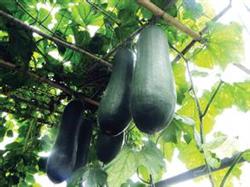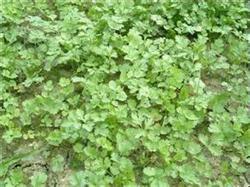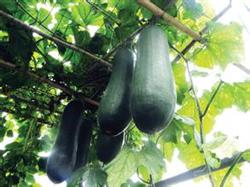Efficient Cultivation Techniques for Small Wax Gourd

In recent years, the market demand of small wax gourd has gradually expanded. It can be cultivated early in spring and late in autumn in protected areas, combined with open field cultivation, listed in May-December, and obtained high benefits in the form of gift vegetable combination packaging and brand sales. Variety selection is rich in small white gourd varieties at present, such as Sui Xing, Qixing, Jiangxin, Yueke No.2, Yueke No.6, Cuibeibei, Green Jade, etc., while small white gourd varieties include early green, green bell, green spring, early youth, Huazhen, Jinpeng green, Qingpi small white gourd, etc. Because of the great difference of plant growth characters among varieties, some varieties have female flowers at the tenth node or so, while some varieties have female flowers at the twentieth node or so, suitable cultivation methods should be determined according to the characteristics of varieties. The yield per mu varies according to cultivation season and cultivation method, generally 1500~3500 kg. Seed treatment The seed coat of small wax gourd seeds is firm and needs seed treatment. Soak seeds in warm water at 55℃ for 15 minutes, and wait for the water temperature to cool to 30℃ for 6 hours. Wash the seeds clean, wrap them with wet towels, place them under 30℃ for germination, and sow when the seeds are white and the buds are about 0.5 cm long. Generally, seeds of better quality can germinate in 2 to 3 days. 20~30℃ was suitable for maintaining the growth of wax gourd, and 25℃ was suitable for flowering and sitting. Therefore, early spring cultivation and late autumn cultivation should strengthen heat preservation. High temperature season should pay attention to ventilation and cooling. Meet the light of small wax gourd, cultivation density can not be too large. Good lighting is conducive to plant growth and melon coloring, but to avoid strong light, in case of burns melon. Fertilizer and water management small white gourd root system developed, hi deep fertile soil, should be deep ploughing, more organic fertilizer. Its stems and leaves luxuriant, melon water content is high, water demand is large, especially stem vine growth and young melon growth process to water demand is higher. According to research, every 5000 kg white gourd production requires 15~18 kg of pure nitrogen, 12~13 kg of phosphorus pentoxide and 12~15 kg of potassium oxide, and the ratio of the three is about 1.3: 1:1. In the early flowering period, fruit early need to control fertilizer and water, stem growth period, fruit expansion period need more fertilizer and water, should be timely fertilization and watering. The stem and vine of small white gourd grow faster and have strong branching ability. If it is allowed to grow, the branches and leaves are too lush, which is not conducive to sitting melon, and it is easy to cause diseases and insect pests. Small-sized wax gourd is mainly composed of main vine and melon, which should be adjusted by measures such as picking, wiping lateral buds, pruning, thinning melon and binding vine. For varieties with higher initial flower nodes, the stems should climb the ground first and then tie the vines to the shelves. Small wax gourd cultivated in protected areas should be pollinated manually in order to facilitate sitting melon. Picks the core to the pollination female flower node position lateral branch, is advantageous to sits the melon and the young melon growth. The main diseases and insect pests on small white gourd are powdery mildew, gray mold, aphid, Diaphania melongensis, Liriomyza zebra, etc., which can be controlled by mulching, pruning, removing withered yellow leaves and weeds, yellow board trapping and killing, etc. Some varieties were basically formed 10 days after flowering, and some were initially formed 20 days after flowering. They should be harvested in due time according to their characteristics and listed in batches.
- Prev

How to grow coriander in greenhouse
1. Sowing coriander is usually sown from late October to early December. Before emergence after coriander sowing, use 250 to 300 grams of herbicide ether wettable powder per mu, or 100 to 200 grams of 50 percent prometryne wettable powder, 75 to 90 kilograms of water, stir evenly, spray the surface of the plot, you can receive good control.
- Next

Cultivation points and technical methods of summer wax gourd
In order to explore the delayed cultivation techniques of wax gourd, farmers in Shanting District, Zaozhuang City, Shandong Province, conducted a summer sowing winter gourd cultivation experiment from 2004 to 2006. The average yield per mu was 4203 kg, and the supply period lasted from October to mid-December. the main cultivation techniques are as follows. One, the variety chooses the meat thick, the skin is hard, the group.
Related
- Where is it suitable to grow horseradish in China? it is expected to see the middle altitude horseradish in Alishan.
- How to prevent tomato virus disease reasonably? (Control methods included)
- Many people like to plant towel gourd on the balcony. What are the main points of this method and management?
- What crops can chili peppers be mixed with?
- Fertilization techniques and matters needing attention in Tomato
- What are the grafting techniques for peach seedlings in spring?
- Harm and control methods of root swelling disease of Chinese cabbage
- What are the pests of sweet potatoes? How to prevent and cure it?
- Symptoms, causes and Control methods of navel Rot in Tomato
- The cause of "Cucumber rotten bibcock" in Farmers' planting Cucumber and its Control Plan

